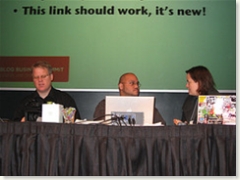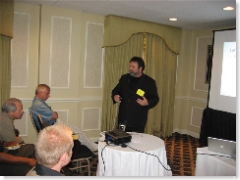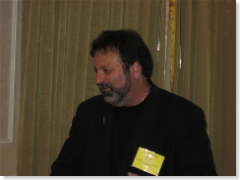 An all star panel – Robert Scoble, Andru Edwards and Mary Hodder – promised to reveal Podcasting and Video Blogging Best Practices.
An all star panel – Robert Scoble, Andru Edwards and Mary Hodder – promised to reveal Podcasting and Video Blogging Best Practices.
Robert Scoble: Start out by knowing the story that you want to tell. And edit it to tell the story from a distinctive perspective.
Expectations of production quality are going up. Rocketboom is using a $1,500 HD camera. While not everyone uses this quality of equipment, people expect better quality sound and images that don’t shake.
If you are using a cheap, on camera microphone, stay close to the subject to eliminate the ambient background noise. A wireless microphone is a worthwhile investment.
Mary Hodder: People will engage more with quality video. So, if you want to reach your audience, it is important to improve the technical quality of the video you post.
Robert Scoble: It’s still early days for video on the web. So, you can experiment.
Andru: Edwards: You can even use a still camera to capture short web quality videos.
Mary Hodder: Freevlog offers good resources for people interested in video blogging.
Robert: It’s a fun community right now. Because people are experimenting and trying things out.
Video bloggers can obtain sponsorship revenues by hosting their video blogs on revver.
For casual video bloggers, Robert suggests they look at bliptv, YouTube, google video or similar services. However, when uploading video to a service like YouTube, read the EULA (licence agreement) closely. You may be giving up the rights to your content.
Libsyn is another affordable solution for hosting podcasts and videos.
Mary’s company, dabble, is a search and sharing site for video. (Robert asked, so it was OK for Mary to talk about it.)









 Last night, the Prime Minister of Canada’s Podcast popped up on
Last night, the Prime Minister of Canada’s Podcast popped up on  Business writer
Business writer 